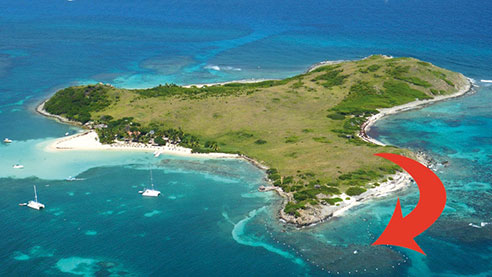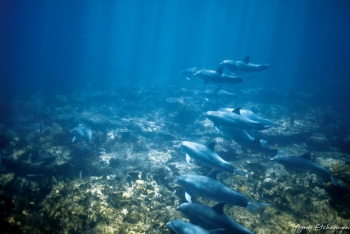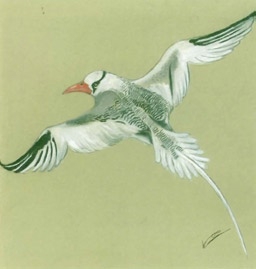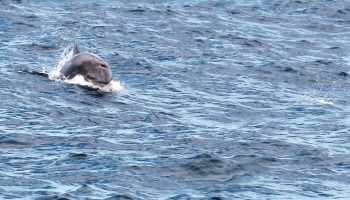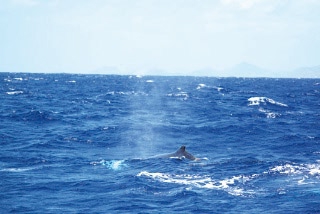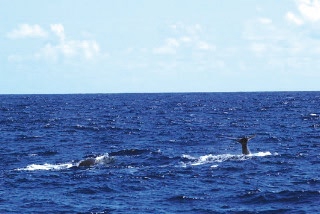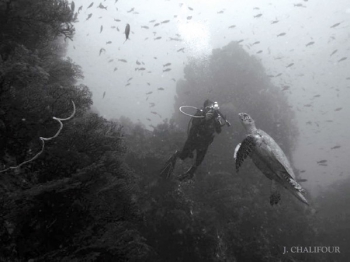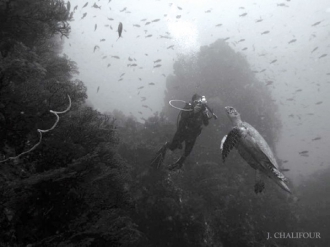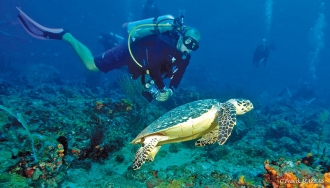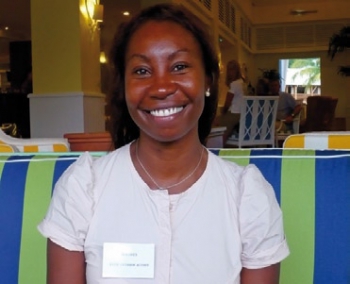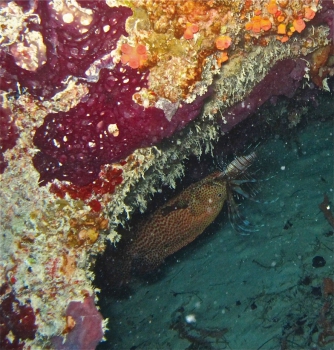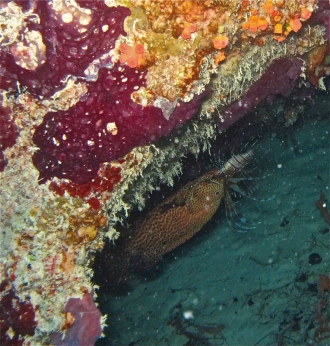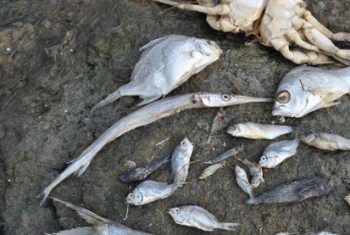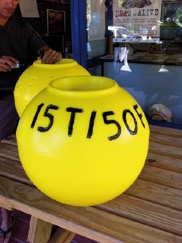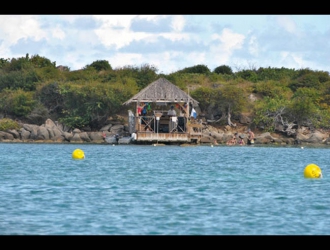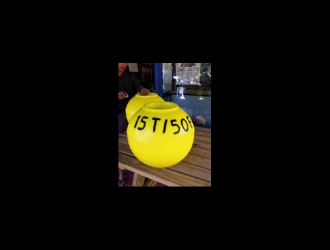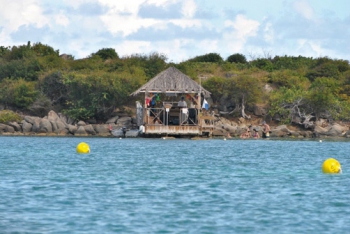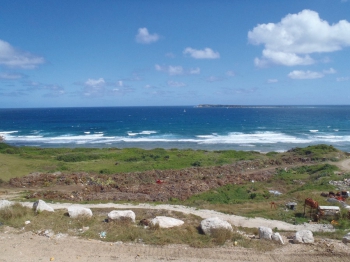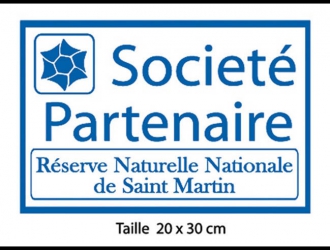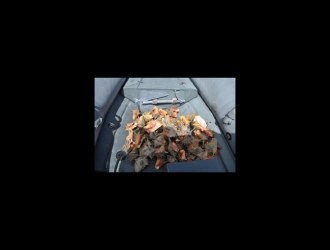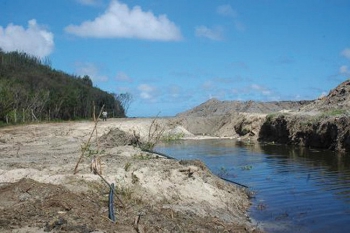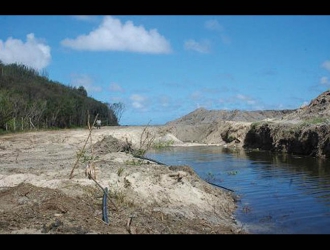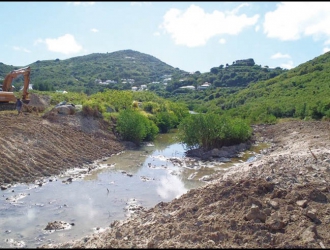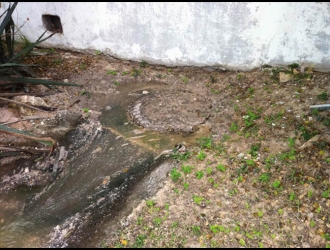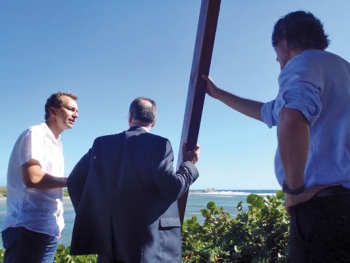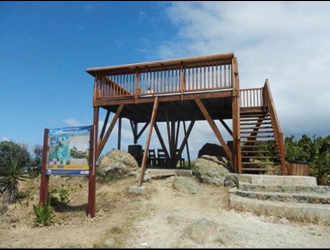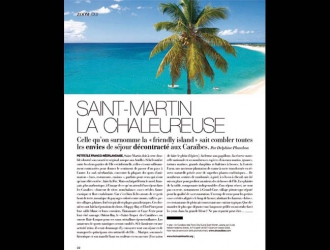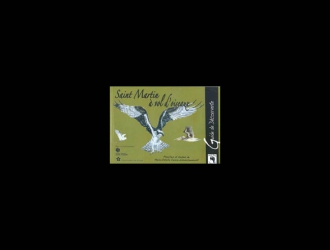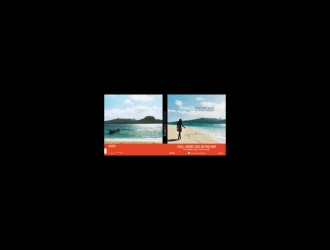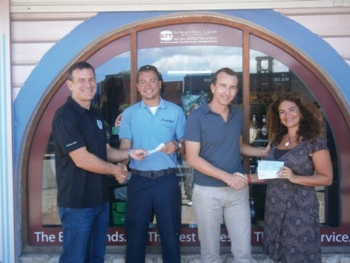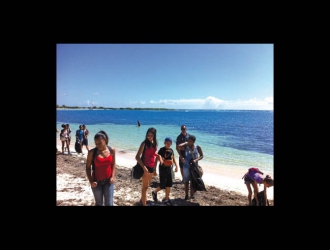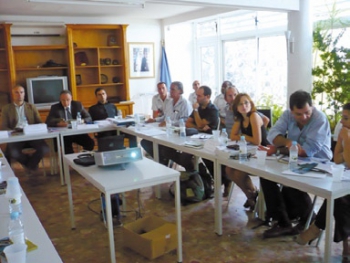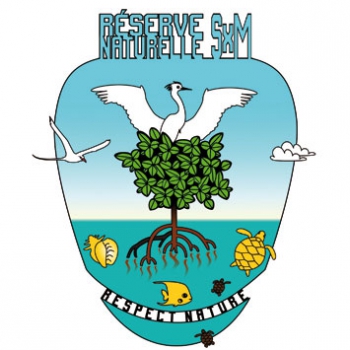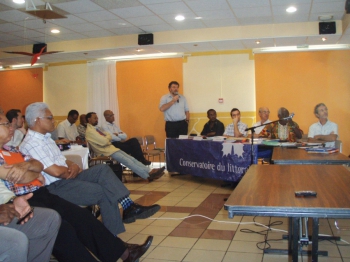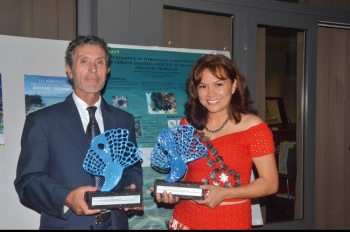Dolphins, humpback whales, sea turtles, tropicbirds, shorebirds…
An incredible array of fauna to be found under the sea, on land, and in the air.
The staff of the Réserve Naturelle observes, counts, and evaluates the wellbeing of these various populations in order to protect our extraordinary natural heritage.
We would like to thank all the eco-volunteers and attentive citizens who share our mission with us: to conserve St Martin’s natural resources as much as possible.
And please follow the example set by Agnès Etchegoyen, whom we thank, in sending us your “nature” photos.
We will publish them on the front page of the Journal de la Réserve.
Get your cameras ready!
Newsletter-14
Newsletter-14
Better Knowledge About Protected Areas And Protected Species
As for the marine bird population, both small and large White-tailed Tropicbirds nest in crevices along Rocher Créole, Tintamare, and Caye Verte: 8 to 9 individual birds were seen on each outing and 36 nests have been counted at the three sites, representing a slight regression since 2009.
The interdiction to anchor in North Cove has proved very positive for the Brown Noddy that nests on Tintamare from March through May, and last season there were 69 different specimens observed and 30 nests.
The Little Tern, which nests in the sand, abandons its nest as soon as it is disturbed, perhaps by a dog, a pedestrian, or worse, a quad. Heavy rains that might flood their nests, or make it difficult to nest in the sandbanks, also endanger these birds. 15 of them could be spotted on each field trip to the Orient Salt Pond and a total of 47 nests were noted at the various sites.
The Roseate Stern was observed for the first time last year near Rocher Créole, Tintamarre, the Pointe du Bluff, and the Orient Salt Pond.
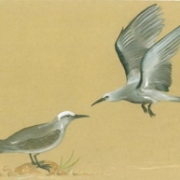 Noddi Brun - Marie Estelle Voisin
Noddi Brun - Marie Estelle Voisin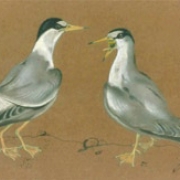 Petit Sterne - Marie Estelle Voisin
Petit Sterne - Marie Estelle Voisin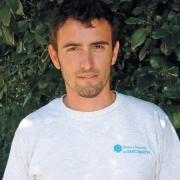 Camille Bouzon
Camille Bouzon Camille Bouzon, a 24 year-old masters degree student in “tropical ecology and agrosystems engineering” at the UAG in Guadeloupe, is doing an internship with the Réserve Naturelle from January 9 through June 15, 2012.
Originally from Marennes, this passionate ornithologist is learning about Saint Martin’s richness is this field.
Since his arrival, he has been studying the division of birds at the various sites and salt ponds, in order to create a zone chart that refines the ecology of these protected species and which can be used in the installation of improvements to the ponds, as spelled out in a study done about the ponds in 2010 and 2011.
He also did a study on the disturbance of birds at the Orient Salt Pond, where traces of all-terrain vehicles were found right to the water’s edge. As we have noted, these disturbances frighten the birds, which take flight, feed less, abandon their nests and ultimately desert the ecosystems that they depend on. In his study of marine and shore birds, Bouzon’s mission also includes improving the protocol for the study, as much as may be needed.
For example, he has proposed to regroup the same types of bids to optimize the counting procedures: the grouping of “Least Sandpipers” and “Semipalmated Sandpipers” into one group of “Small Sandpipers” would be useful in terms of the study and its statistics. Bouzon is also heading up a discussion related to ecotourism, as amateur ornithologists make up an important group of potential tourists.
Two zones of navigation were covered according to the established protocol: the first zone encircles Saba, Saint Eustatia and the Saba Bank; while the second is between Saint Martin, Anguilla, and Saint Barth. Funded by AGOA and the SPAW-CAR, this expedition was led scientifically by BREACH (association in charge of studying the marine mammal population in the AGOA sanctuary) in partnership with the Réserve Naturelle, which should over time become the local scientific reference.
Two boats were used for the staff from BREACH, AGOA, SPAW-CAR and the marine parks of Sint Maarten, Saint Eustatia and Saba, as well as the Réserve Naturelle of Saint Barth and the Réserve Naturelle of Saint Martin.
In 2010 and 2011, 11 visual observations and 16 acoustic observations were made along the 717 kilometers covered by the staff of the Réserve Naturelle, or an average of 1.6 humpback whales per 100 kilometers and relative abundance of 0.026 individual per kilometer.
The 2012 campaign is already more fruitful, based on the observation of several groups of sperm whales, dolphins, and humpback whales near our shores.
The increased number of sperm whale will be an important element in validating the importance of the Northern Islands in terms of the AGOA sanctuary, as these whales were pretty much considered absent in this zone.
Certain observations could even be made directly from the shore, as two adult and two baby humpback whales were seen late one afternoon near the entry to the marina at Oyster Pond.
This sanctuary is dedicated to the protection and conservation of marine mammals in the waters around the French West Indies, including Guadeloupe, Martinique, Saint Barthélemy, and Saint Martin.
The name AGOA is in reference to “Maï d’Agoa,” the mother of the spirit of the water in Amerindian mythology. The sanctuary covers 138,000 km2.
The sites were visited twice a week by the staff and the eco-volunteer partners of the Réserve, for a total of 310 visits.
The hawksbill turtles were more numerous in terms of laying their eggs on the beaches of Saint Martin, while the rarer leatherbacks left just one trace on the beach at Long Bay and a nest on the beach in Orient Bay without evidence of eggs as the turtle was most likely disturbed by light and people (see issue n°12 of this Journal, which you can download at www.reservenaturelle-saintmartin. com).
The sea turtles prefer the beaches at the lagoon on Tintamare, Coralita, and Long Bay.
Julien Chalifour, director of the scientific department for the Réserve, has noted an overall regression in the number of turtles seen since 2009, especially on the beaches of the Lowlands. However, the same generation of sea turtles only lays eggs every other year, so this trend could reverse itself this year. At the same time, the diving clubs in the INASCUBA network observed 222 sea turtles during 312 various dives on 30 different sites, with the height of the sightings in February 2011. As a matter of course, at the end of each dive, the clubs fill out a form indicating the number of sea turtles that were spotting, as well as their species.
The “Sec de Grand-Case” of the French side, Charlie Shoal and Proselyte Reef on the Dutch side, hold the record for the most sea turtles, yet even here their numbers are slightly lower.
There were also fewer dive clubs participating, as the follow-up takes a certain amount of time every day. As a result the Réserve is once again going to try and mobilize the professional divers.
Most of them were trained on March 5 in the monitoring protocol and thus can identify traces of turtles that come to nest on the beaches, and differentiate the species. A second session was organised in late March, just before the hieght of the egg-laying season in April.
En général, les touristes recherchent la nature la plus naturelle possible et je les informe qu’ils se rendent sur un territoire protégé lorsqu’ils vont à Tintamare ou à Pinel.
Ils savent qu’ils vont trouver une faune et une flore plus riches que partout ailleurs et ils ne reviennent jamais déçus ! ».
COOL.. and NOT COOL..
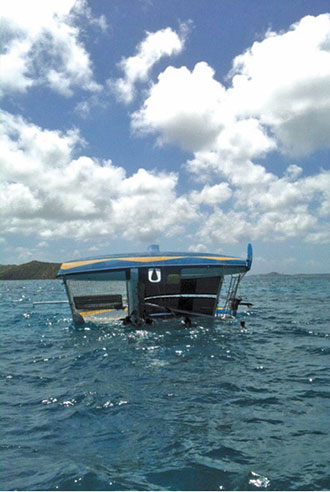
COOL
L’équipe de la Réserve était sur l’eau pour la Heineken Regatta et a aidé la SNSM à remettre d’aplomb ce catamaran retourné.
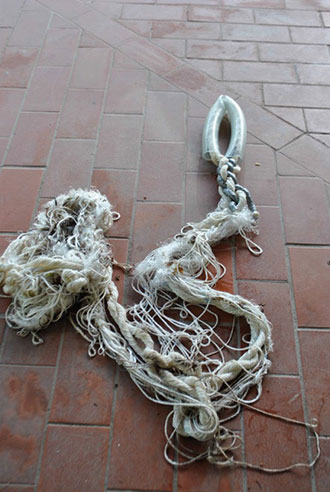
NOOT COOL
Plaisanciers, attention à la manoeuvre ! Respectez les mouillages mis en place pour vous par la Réserve naturelle.
Managing The Impact Of Human Activities In Protected Areas
In mid-March, 116 lionfish were captured in Saint Martin and more than 200 have been seen since they were first captured on July 20, 2010.
Three victims who have been stung were admitted to the emergency ward at the hospital and lionfish have invaded the site of Rocher Créole.
During the last committee meeting, Franck Mazéas of DEAL Guadeloupe (Ministry of Ecology), explained that the French West Indies are aware of the problems caused by the lionfish on other islands of the Caribbean, where as many as 80% of fish disappear in zones that are invaded by this species.
This trend is negative for fishermen, business and the ecology, not to mention the risk of getting stung. DEAL hopes to employ a new regional strategy already put into place on other islands, which is to control the development of the lionfish, as its eradication is impossible, and specimens have been found as deep as 80 meters and more.
The control comprises: - capture as many lionfish as possible (by authorized persons) - inform the public - warn hospitals, doctors, firemen, fishermen and dive clubs on what to do in case of a sting The more than hundred of these fish captured in Saint Martin were analyzed to see if they are edible or if they carry the toxic ciguatera, but the Marine Park in Sint Maarten analyzed lionfish from Jamaica which carried evidence of the toxin. It is no longer necessary to bring lionfish to the Réserve, as the present thinking it to cut them in half after they have been killed and leave them in the water, in order to: - provide food for other species - hope that potential predators develop a taste for them and start hunting them.
The Sea Dolphin club, which saw a grouper and a green moray eel devour a lionfish, took a few photos (see picture). DEAL hopes that the Réserve de Saint-Martin will go beyond its immediate zone of capture and has every means needed to do so. A grouper enjoying the flesh of a lion
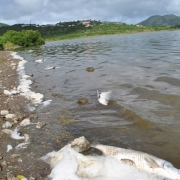
Why were there hundreds of dead fish in the Orient Salt Pond at the end of 2011? On both November 9 and December 8, the Réserve visited the site, as local residents had alerted them to the situation.
The second time, a water sample was sent to the Institut Pasteur for analysis and the results were revealing: an abnormal level of enterococcus and E coli, much higher than the level found a few months earlier in a test by the Littoral Conservancy. This links the pollution to waste water from toilets.
Perhaps there was a malfunction in one of the private water treatment plants or in the public system that empty into the pond?
The Réserve Naturelle required the operators in question to evaluate their equipment and make any repairs that are needed.
If nothing is done, the Réserve will take the necessary steps to have the situation corrected.
The decision to standardize the color of mooring buoys in Saint Martin, Sint Maarten, Saint Barth, Saba, and Saint Eustatia is already in effect in Saint Martin.
The goal of this project, launched at an annual conference for the Northern Island in September 2011 by the managers of protected marine park zones on these islands, is to simplify communication with pleasure boaters and divers throughout the region, who will know that the yellow buoys are reserved for pleasure boats and the white ones are for dive boats.
Agents from the Réserve have thus installed 17 yellow buoys on mooring blocks at Tintamare, 14 at Pinel, and 3 at Rocher Créole, for a total 34 moorings for pleasure boats.
At Pinel, the six moorings stolen in 2011 have been replaced with environmentally friendly concrete blocks, made with crushed glass instead of gravel.
A total of 16 white buoys are available for dive clubs: 9 at Rocher Créole (6 for dive boats and 3 for dinghies) 1 at Pinel, 1 at Caye Verte, 1 at Basse Espagnole, 3 at Tintamare, and 1 at Galion, near the surf spot.
The Réserve Naturelle is keeping a close eye on the ecosite in Grandes Cayes, where most of the trash from the French side of the island is treated, close to the edge of the Réserve, just beyond the high-water mark and a few steps from the Sentier des Froussards.
The company running the eco-site - Verde Environnement Saint-Martin - is currently studying an extension project in order to rationalize these zones and to better deal with the pollution caused by toxic liquids produced by the trash.
On January 26, 2012, president Patrick Villemin took Réserve Naturelle and the Littoral Conservancy to see the site and present the project to them.
After this meeting, Romain Renoux and Béatrice Galdi (from the Littoral Conservancy) sent their opinions to Villemin with an eye to limiting the risk of pollution as much as possible, as well as improve the eco-site itself, by adding landscaping, for example, at the entry to the site.
The management should also remove a large quantity of vegetal debris, that has encroached onto the territory of the Réserve and choked the vegetation, and then replace what has been ruined with stricter respect of the property lines.
It has also been requested to limit trash being carrying as far as the beach by the wind, to avoid pollution from toxic liquids and to ensure the quality of the marine milieus located below the areas where the trash is stocked.
During the last advisory committee meeting, the question of banning kite surfing in Galion Bay was on the agenda.
The Réserve manages this protected marine site according to the variety of uses - swimming, surfing, windsurfing, horseback riding, snorkeling - and is evaluating the impact of these activities on the natural environment.
Romain Renoux proposed the creation of a users committee to unite the various parties in an exercise to see how each use of the bay can be taken into consideration.
Illegal Capture of 63 Conchs
A poacher caught with 63 conchs - most of which were juveniles - just captured in Réserve Naturelle, came before the court in Saint Martin on March 8.
He was accused of 11 charges and required to pay 100 euros per charge and sentenced to two months in prison, although both the fine and prison term were suspended.
If he is caught poaching again, he will be required to pay the fines and go to jail.
A kite-surfer caused a horseback riding accident at Galion Bay
In spite of the prefectural edict banning the sport in Galion Bay, on January 16, 2012, a kite-surfer frightened a horse by coming too close to the beach and causing the rider to fall.
The young woman was taken to the emergency room at the hospital.
Back at Galion Bay, marine park warden Steeve Ruillet filed a complaint against the person for not respecting the ban and practicing a sport that is not allowed within the marine park.
The kite-surfing gear was conditionally seized, meaning that the owner can keep it as long as he doesn’t use it within the prohibited zone. The guilty party will be called before court in Saint Martin.
60 businesses partner with the Réserve Naturelle
Only the 60 businesses having signed an agreement with the Réserve Naturelle are officially considered its partners.
A dive club from the Dutch side found out the hard way after lying about a non-existing partnership in their advertising. The Réserve had previously - on two different occasions - presented a partnership dossier to the director, who did not respond.
The Réserve filed a complaint against this company in Sint Maarten via the court in Saint Martin, which sent it on to Basse Terre, following the proscribed procedure for business issues with foreign entities.
Restoration Of Degraded Areas And Populations
En janvier 2012, au sud de la plage de l’Anse Marcel, le remblais déposé illégalement en 2009 à l’embouchure du petit étang a été enlevé et le talus aplani, permettant de nouveau une meilleure communication entre l’étang et la mer.
Ces travaux ont été réalisés par le contrevenant, qui avait également arraché une partie de la mangrove à la même époque et avait alors été mis en demeure par la Réserve naturelle de remettre les lieux en état.
La végétation de type invasif qui recouvrait le remblais a été défrichée, mais il reste à planter des palétuviers dans la mangrove et des raisiniers en arrière plage, ainsi que des espèces caractéristiques de la forêt sèche.
Une pollution qui n’en finit pas
Alerté le 5 janvier 2012 par l’association des riverains des Terres Basses, Romain Renoux, le directeur de la Réserve naturelle, a constaté sur place un écoulement d’eaux usées répugnantes dans le Grand Étang des Terres Basses, en bordure d’un hôtel.
Le dysfonctionnement est apparemment dû au débordement d’un poste de relevage et n’est pas nouveau. Déjà en 2009, la Réserve naturelle avait dressé un procès-verbal au contrevenant.
La Réserve naturelle a contacté l’Établissement de l’eau et de l’assainissement de Saint-Martin (EEASM), qui a tenté de diagnostiquer le problème.
Une rencontre a été organisée sur le site entre la Réserve, la direction de l’hôtel, la préfecture, l’EEASM et la Générale des Eaux, en vue de résoudre définitivement la question, selon les préconisations de l’EEASM.
L’équipe de la Réserve reste très vigilante au sujet de cette pollution, le Grand Étang constituant un patrimoine naturel d’exception et totalement protégé.
Environmental Communication And Education
On January 16, a few weeks after his arrival on the island, Philippe Chopin met the staff of the Réserve Naturelle it its offices in Anse Marcel.
The new prefect then embarked on the boat belonging to the Réserve, accompanied by his cabinet director Mathieu Doligez, the secretary general of the prefecture Afif Lazrac, and Pierre Leconte, the environmental engineer representing the prefecture in terms of sustainable development.
The prefect, who enjoys being on the water, discovered Rocher Créole, Tintamare, and Pinel, and was able to evaluate the missions and challenges of the Réserve, as well as the difficulties it faces in executing its functions.
Very sensitive to the preservation of natural resources, he appreciated the improvements that have been made - signage, moorings, picnic-tables, shelters, nature trails - and understood by observing the level of commercial activity around the islands that these protected areas - still far from becoming a sanctuary - represent a tool, and a real asset, in terms of the further development of tourism in Saint Martin.
On January 27, Romain Renoux and Béatrice Galdi, from the Littoral Conservancy, took Philippe Chopin and Mathieu Doligez on a field trip to discover the land-based aspects of the Réserve and the Littoral Conservancy.
They visited the Coralita site, along the shore and Galion Bay.
They both admired the eco-tourism improvements added here - the whale watching observatory, the shelters, the informational signage - and at the Carti site they were able to see an example of a site that had been seriously degraded and which Réserve plans to make a pilot site, opening it to scholars and to tourists.
This visit, scheduled a few days before the Réserve’s advisory committee meeting allowed the prefect to thoroughly comprehend all of the items on the agenda.
Coralita: a good site for cultural enrichment
Informational signage was added to the whale watching observatory and the two shelters opened in 2010 by the Littoral Conservancy at the important Coralita site, visited by numerous tourists, completing the improvements at this eco-tourism site.
A general information sign is located at the entry to the site, while a sign presenting the protected marine species can be found in each of the shelters.
Finally, three signs in the observatory explain the marine and land-based ecosystems as well as the good practices allowing the public to enrich its knowledge.
The Littoral Conservancy with support from Europe (FEDER) financed this project.
Oui likes the Réserve Naturelle
Oui Magazine, a chic quarterly about weddings, did not forget the Réserve Naturelle in its article “Saint Martin la chaleureuse”, written by Delphine Planchon and published in February 2012.
The journalist recommended that her readers visit the small islands of Tintamare, Pinel, and Caye Verte while underlining the importance of the flora and fauna that one can see on land and at sea within the boundaries of the Réserve.
Thank you, Oui!
Saint Martin for bird lovers
Nature lovers and bird watchers will be happy to discover the 24 beautiful drawings designed by Marie-Estelle Voisin, biologist, artist and resident of the island for the past 10 years. Presented in a booklet called “Saint Martin à vol d’oiseaux”, each drawing is accompanied by a detailed commentary about the bird that is pictured: how to recognize it, its feeding patterns and its reproductive behavior.
An observation guide and several maps encourage amateurs to get out the binoculars to observe the Great Egret, the Grey Plover, the Yellow- crowned Night Heron or the Pied-billed Grebe. For beginners, this is a good way to encounter the salt ponds and the shoreline, exceptional homes for a certain number of protected species.
The Réserve Naturelle and the Littoral Conservancy joined forces with the author to help fund this booklet as part of their mission of environmental education.
It is available at the Maison de la Réserve at Anse Marcel and will be for sale shortly in the island’s bookstores.
“Rivages d’outre-mer:” the Conservancy in far-away France
2011 was the year of Overseas France and the perfect opportunity for the Littoral Conservancy to prepare the publication of “Rivages d’outre-mer” (Overseas Shores), which has been on sale in bookstores since early 2012. With 80 pages and several hundred beautiful photographs emblematic of the shores of the Atlantic and Indian Oceans, this book retraces the ongoing activities of the Conservancy for the past 30 years in the eight Overseas Collectivities, including Saint Martin.
The presentation of each collectivity is personalized by the observations of a resident - Kate Richardson in Saint Martin, for example - and his or her vision about the necessity to protect the coasts and the emotions that these exceptional sites evoke on a personal basis. A book that is perfect for everyone, naturally.
Cette année encore, les organisateurs de la Heineken Regatta ont vendu des bracelets verts au profit de l’environnement et ont remis un chèque de 2500 dollars à la Réserve naturelle de Saint-Martin et à la Sint Maarten Foundation.
Romain Renoux indique que cette somme sera réinvestie dans la réalisation du suivi scientifique de l’état de santé des récifs dans la Réserve.
Lamartine au Galion
Une trentaine d’élèves de l’école Lamartine ont bénéficié d’une sortie pédagogique et écologique sur le site du Galion, en compagnie des gardes Christophe Joe et Steeve Ruillet. Très motivés, les jeunes ont terminé la visite par un nettoyage de la plage. Bravo !
Une publication scientifique à l’école de Cul-de-Sac
Les botanistes en herbe du CM1 de l’école primaire de Cul-de-Sac travaillent sur un projet de livre numérique, destiné à présenter les trois grands écosystèmes qui composent la partie terrestre de la Réserve naturelle.
Ils se sont tout naturellement tournés vers la Réserve pour les aider à mener à bien leurs recherches et sont ainsi partis deux fois déjà en expédition dans la nature, en compagnie du garde Steeve Ruillet, lui-même très intéressé par leur travail.
Très attentifs, ces élèves ont scrupuleusement noté toutes les informations données par le garde et pris les bonnes photos, sur la plage de Grandes Cayes pour la végétation de bord de mer, autour de l’étang de la Barrière pour la mangrove et bientôt sur le sentier des Froussards, pour la forêt sèche. Plus d’informations sur ce livre dans notre prochaine édition !
Better Means For Better Missions
The most recent advisory committee of the Réserve Naturelle was held on February 1, 2012.
Presided by prefect Philippe Chopin, the meeting gathered all of parties involved in the management of this protected zone: The French government, the Collectivity, the end-users, the scientists, the CESC, neighborhood councilors and the Marine Park of Sint Maarten.
This was also the occasion to present a detailed report on all of the Réserve Naturelle’s missions and a recap of all activities in 2011.
There are two important points to remember: the first concerns the fights against the lionfish and the creation of a working group dedicated to battle against this invasive species (see related article on page 10); and the second point relates to Galion Bay and the creation of a committee comprising the Réserve, the French government, the Collectivity and end-users in order to better govern the various activities taking place at this site, where kite-surfing is sometimes practiced at the site in spite of the prefectural interdiction (see article on page 14).
At the request of the prefect, a second advisory committee meeting will be held each year in September or October.
Reinforcement On A Regional
Improving the management of Protected Marine Areas (AMP) by reinforcing regional cooperation is a strong desire for the TE ME UM (Ultra Marine Lands and Seas) networks, the Agency for Protected Marine Areas and CaMPAM, which had invited the managers of the AMP for the Northern Lesser Antilles to participate in a technical workshop for natural sites. This workshop was organized in Saint Claude in Guadeloupe from December 12-16, 2011, and based on the idea of technical collaboration.
The Réserve Naturelle of Saint-Martin was there, as well as the Regional Natural Park of Martinique, DEAL in Martinique and Guadeloupe, the National Park of Guadeloupe, the Réserve Naturelle of Petite-Terre, the Réserve Naturelle of Saint Barth, the Marine Park of Saint-Eustatia and the Marine Park of Sint Maarten.
A member of the Haitian environmental ministry and a member of an environmental association represented Haiti, a nation that is concerned about the decline of marine fauna in its waters and would like to establish an AMP in a fishing zone.
This workshop encouraged fruitful exchanges between the 20 managers and the others present, especially on the art and technique of managing an AMP, how to conduct a negotiation, or interactive management with those who use an AMP, or how to lead an inquiry about the perception of an AMP.
The Agency for Protected Marine Areas accented the marine mammal sanctuary in the French Antilles (AGOA) and the CAR-SPAW (Center of Regional Activities For Specially Protected Area and Species), which works for the protection and the promotion of Caribbean marine milieus, made a presentation.
TE ME UM presented the financing that all managers of natural ultramarine zones should have for training, and the Dutch Caribbean Nature Alliance, based in Bonaire, spoke of the monies it has dedicated to AMPs in the Caribbean and presented certain of its already completed projects. The CaMPAM, whose mission is to support the creation and management of AMPs in the Caribbean and whose network comprises at least 200 of these areas, also shared its experiences.
The workshop concluded with a fieldtrip to the Islets Pigeon, for a session of whale watching, opening the door to a discussion of the activities practiced by private companies, interactions with fishermen, and the AGOA sanctuary.
The Council of French Coasts In The Americas (CRFA) was held on February 9-11, 2012 at Sinnamary in French Guiana.
All of the branches of the Littoral Conservancy in the Americas were there and Pierre Aliotti, vice president of the Collectivity of Saint Martin, was elected president of the CRFA, representing the Northern Islands.
The CRFA members expressed their concerns about the proposition for the modification of a law by the Senate, which requests a transfer of responsibility for the environment, currently the responsibility of the French government, to the Collectivity of Saint Martin. In this context, the coastal council is concerned about the future preservation of the environment and the coastline in particular.
A special motion was adopted with this in mind: “In the local context of string pressure for the urbanization of the shoreline, the coastal council is concerned about the eventual modification of the current regulations of protection for the natural sites in Saint Martin.”
The originality of the underwater trail project in Pinel allowed the Collectivity of Saint Martin to receive the top award from the French Initiative For Coral Reefs (IFRECOR) 2011.
This first IFRECOR competition, promoting coral reefs, was open to all administrations in French Overseas zones during the 2011 yearlong celebration of Overseas France and was designed to honor elected officials who had created a sustainable management program for “their” reefs.
Pierre Aliotti, vice president for the environment, was the winner on December 15, 2012 during the 26th general assembly for the International Coral Reef Initiative, which was held on Reunion Island.
This project was made possible thanks to co-financing from the Réserve Naturelle, the Littoral Conservancy, and FEDER funds.
